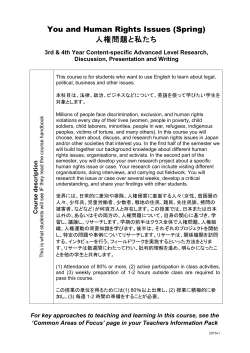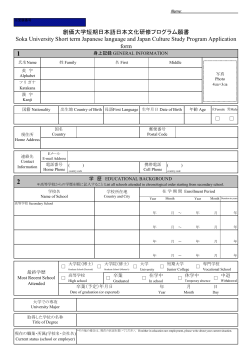
Japan in East Asia (Spring) æ±ã¢ã¸ã¢ã«ãããæ¥æ¬ - C
Japan in East Asia (Spring) 東アジアにおける日本 3rd & 4th Year Content-specific Advanced Level Research, Discussion, Presentation and Writing This course is for students who want to use English to learn about legal, political, business and other issues. Course description This is what students will see IF they read the course handbook 本科目は、法律、政治、ビジネスなどについて、英語を使って学びたい学生を 対象とします。 In this course, we will develop our understanding of current relations between Japan and China, North and South Korea, and Taiwan by learning about Japan’s historical relations with these countries. We will develop our historical knowledge by looking at Japan’s colonization of Korea and occupation of parts of China, and at the experiences of Korean and Chinese migrants in Japan. You will then focus on current political, cultural and economic issues of interest to you such as territorial disputes with China and Korea, recent controversies about history textbooks and Japan’s treatment of Korean ‘comfort women’, Japanese policies towards North Korea, Japanese pop culture in East Asia, and Japanese companies’ employment practices in China. Throughout the course, you will use English to develop your understanding of these issues through research, critical analysis and discussion with other students. この授業では、日本と中国、北朝鮮、韓国、台湾との間の歴史的関係を学び、 これらの国々と日本の現在の関係について考えます。日本による韓国の植民 地支配や中国領土の一部占領、また在日韓国人・中国人たちの体験に着目し て、歴史の知識を養います。それから、中国や韓国との領土問題、歴史教科 書問題、韓国人従軍慰安婦問題、日本の対北朝鮮政策、東アジアに広がる日 本のポップカルチャー、中国における日系企業の雇用慣行など、各自興味の ある今日の政治、文化、経済問題に取り組みます。コースを通し、英語を使っ てリサーチや批判的分析、他の学生との議論を行うことにより、これらの問題 への理解を深めます。 (1) Attendance of 80% or more, (2) active participation in class activities, and (3) weekly preparation of 1-2 hours outside class are required to pass this course. この授業の単位を得るためには(1) 80%以上出席し、(2) 授業に積極的に参 加し、(3) 毎週 1-2 時間の準備をすることが必要。 For key approaches to teaching and learning in this course, see the ‘Common Areas of Focus’ page in your Teachers Information Pack 2015v1 for this course • Use multiple sources of English information for research • Student choice of research issues • Student-centered activities • Presenting and exchanging information in small groups of 2-4 Resources for this course Class Schedule • Frequent rotation of pairs and groupings This may be read by students BUT teachers can adapt it and make a more specific class schedule for their students Requirements • 2-3 cycles of research, discussion, presentation and writing • Online on the taught-in-English website: http://c-faculty.chuo-u.ac.jp/~mikenix1/teachers.html • On paper in the Teachers’ Room Week 1: Course introduction, explanation of course requirements, goalsetting Weeks 2-13: Two or three cycles of background reading and research, discussions, presentations and writing on issues of students' choice related to Japan in East Asia Week 14: Reflection and self-evaluation/assessment Week 15: Class survey and review of the semester 2015v1
© Copyright 2025





















